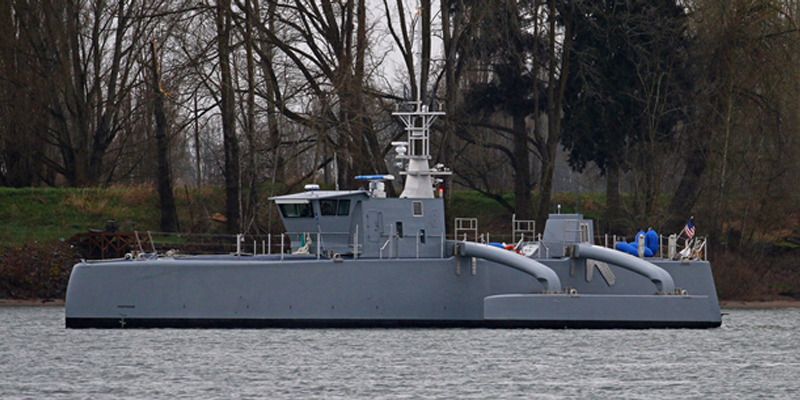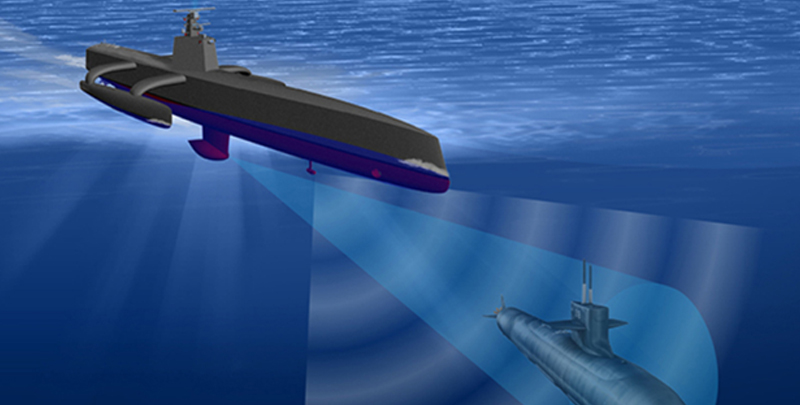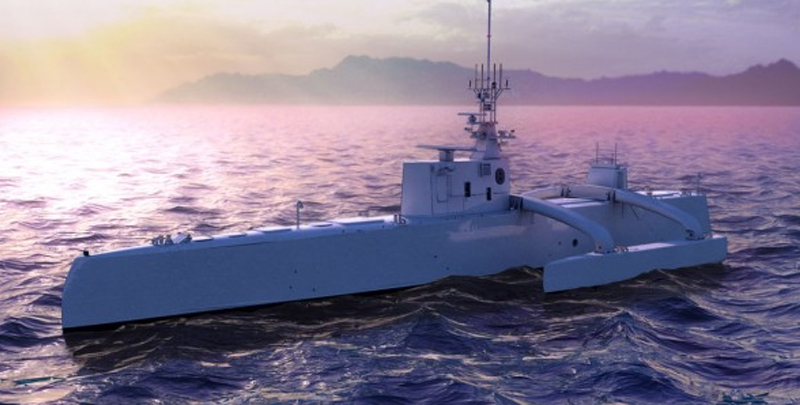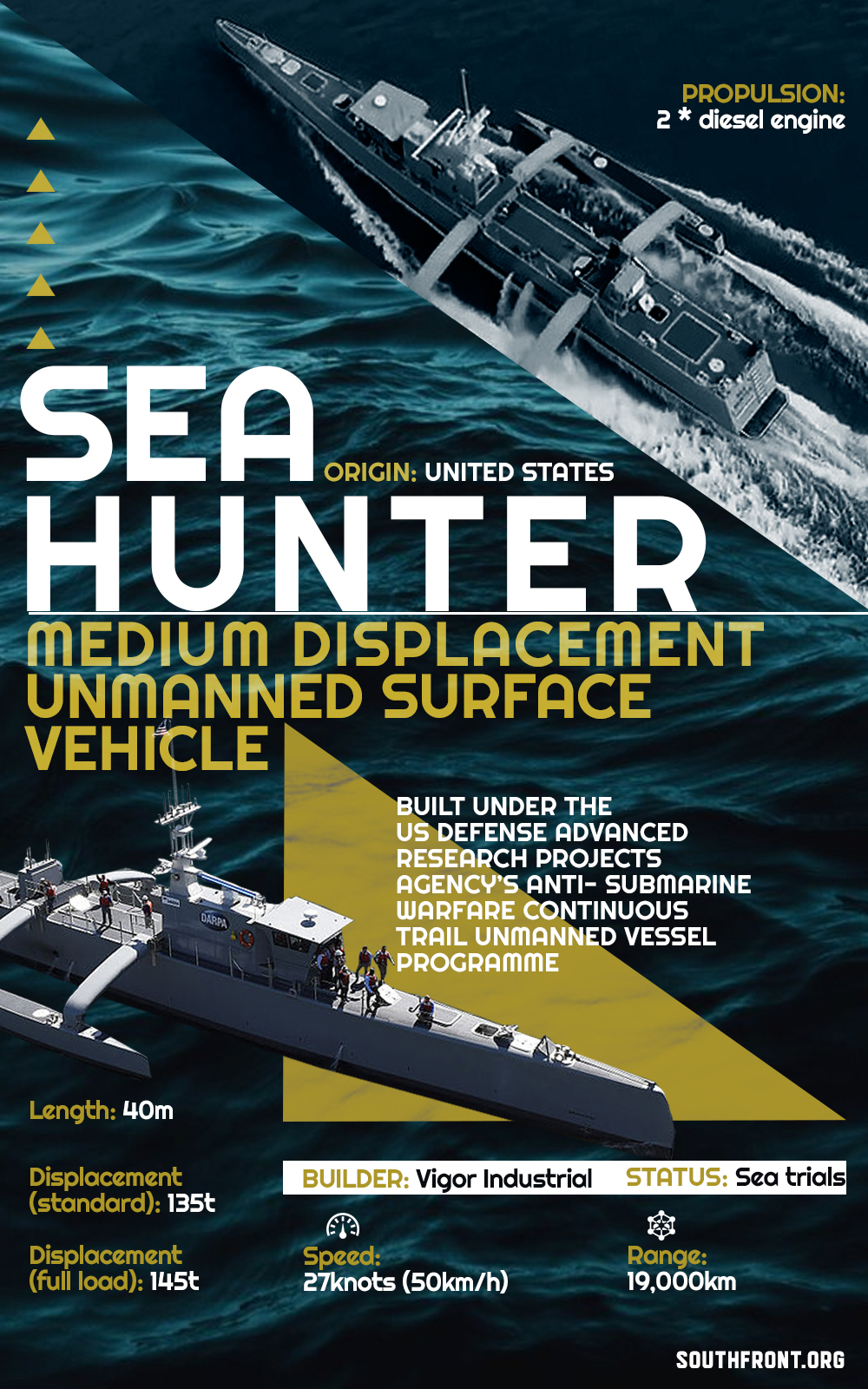The Sea Hunter is an autonomous unmanned surface vehicle developed and launhed as part of the DARPA Anti-Submarine Warfare Continuous Trail Unmanned Vessel (ACTUV) program.
DARPA’s Sea Hunter: The Future of Anti-Submarine Warfare? (6.05.2016):
The U.S. Navy christened the Defense Advanced Research Projects Agency (DARPA) developed autonomous surface vessel, named Sea Hunter, in Portland, Oregon on April 8th. The vessel was moved on a barge to Naval Base San Diego, and extensive sea trials, planned to last two years, began May 2nd. The vessel’s mission is to test the feasibility of a fully autonomous drone surface vessel.
The Sea Hunter currently has accommodation for a small crew, who will be traveling on the vessel and conducting a multitude of tests. The vessel has a length overall of 132 feet, and has a trimaran hull design. It is reported that the vessel has a top speed of 27 knots. While the hull design does not have the maneuverability of a mono-hull, it benefits from increased stability in a seaway.

Sea Hunter ACTUV on the Willamette River, Oregon
DARPA partnered with Virginia-based Leidos, to develop the Anti-submarine Continuous Trail Unmanned Vessel (ACTUV) program and build the Sea Hunter. The ACTUV concept envisions a fully-autonomous drone ship that can stay at sea for months at a time, without need of replenishment, and has an effective range of 10,000 nautical miles. The main mission of the vessel would be to detect and track submarines, and possibly conduct mine-countermeasures missions.
The vessel will use a combination of new and proven technologies, such as GPS, advanced radars and sonar, to navigate the vessel, to acquire and track targets, and to develop an artificial sense of situational awareness so that the vessel can maneuver in accordance with the International Regulations to Prevent Collisions at Sea (COLREGS). In order to gain full autonomous capability, the vessel must be capable of operating in a safe manner and in accordance with all laws governing safe navigation at sea. It is hoped that the two year training program will provide the insight and practical experience that will lead to full autonomy.
There are many hurdles that need to be overcome to take the Sea Hunter from concept to reality. It is one thing to attain enough collision avoidance capability for the vessel to operate at sea, well away from coastal waters, but another thing all together for the vessel to be able to operate independently in high traffic areas. It may end up being more feasible to retain the ability for human piloting of the vessel during arrival and departure from harbors and coastal waterways, transitioning to unmanned operation in open oceans. As any naval officer or merchant mariner knows, the sea is a very unforgiving and unpredictable environment, and the difference between survival and tragedy often depends upon the good judgement, insight and instincts that are honed in an individual over time. Without the ability to learn, can a robot vessel hope to survive in the unpredictable environment of the high seas, let alone avoid accidents presented by man-made and natural hazards to navigation?
Anti-Submarine Warfare and Mine Countermeasures
There are many benefits of a high endurance naval platform that can detect and then track foreign submarines for an extended period of time, while requiring no replenishment, and that also incurs only a fraction of the cost of a traditional ASW surface combatant. This was the primary role envisioned for the ACTUV in early development. Considering that ASW warfare is an art as much as a science, and that human nature (stealth, strategy, gambits, bluff) and the relative human deductive reasoning associated with such behavior, are outside of the capability of autonomous drone capabilities (or are they?), it remains to be seen how effective the ACTUV will be in this naval warfare realm.

ASW is a primary role for the ACTUV concept
Perhaps, mine countermeasures (MCM) warfare is a more apt role for the ACTUV platform. Even though naval mines have become increasingly more complex and intelligent than ever, they do not have a human intelligence component like a submarine does. An autonomous robot will have a greater degree of success detecting and countering a similar intelligence and will remove the human component from the inherently dangerous task of mine deactivation, removal and disposal. It is easy to envision an ACTUV employing smaller “suicide” drones to fool advanced naval mines into attacking them and thus removing the mines as a threat to manned vessels. Even as an MCM vessel employed in a low threat environment, after the main naval engagement has been fought and naval mines need to be engaged and disposed of, this is a viable role for the ACTUV. The potential number of human lives saved is well worth the $20 million USD per unit price tag estimated for the naval drone. As has been the case with most U.S. military programs over the past twenty years, the cost will most likely increase substantially.
Ethical Considerations and Vulnerabilities
Not long after viable drone technology became common place on the battle fields of the world, did the ethical ramifications of the technology present themselves. The more removed from the act of killing humans become, the easier the act becomes, and the less human emotional impulses to refrain from such abhorrent behavior hold sway in prohibiting such acts. The most reprehensible and vile of all human acts, regardless of the circumstances and the intent, is the taking of other human life. When technology allows humanity to absolve itself of the act of killing, through physical and spatial separation, there is a real danger that a propensity to conduct such behavior becomes easier to bear, and thus to absolve in the minds of men.
There are no present plans to arm the Sea Hunter; however, with the move toward a completely autonomous robot vessel, the very real problem of responsibility and accountability presents itself. Who is accountably for the damage to property and/or the loss of life that may result from a collision at sea? In a maritime law case, who can stand witness for the Sea Hunter? Would the recorded track and alterations to course steered and engine speed/direction in the autonomous drone’s “memory” be legally admissible in court? Could this recorded data be open to manipulation after the fact, to absolve the government of wrong doing and of legal responsibility? These are all considerations that must be weighed when considering the ethical ramifications of this technology.

Artist’s rendition of Sea Hunter. An ASW and MCM, totally autonomous naval vessel
Additionally, whenever new technologies are invented and utilized, so too are the means to circumvent or defeat them. Talented computer hackers have increasingly exhibited their proficiency at hacking the most high-tech and encrypted systems, whether they be information storage, communication or drone control systems. Sea Hunter is no different in concept. It is easy to imagine the damage that could be inflicted by hijacking even an unarmed Sea Hunter. Any ill-intentioned party could hijack such a vessel and steer it at full speed into a cruise ship. If the autonomous vessel was armed, the outcome of such an event could be horrible.
Non-Military Applications
Perhaps, in an attempt to steer attention away from the military applications and the accompanying controversy of the Sea Hunter, DARPA was quick to harp on the possible civil uses of autonomous surface vessels. It was hinted that the technology could usher in a new era of crew-less merchant vessels. If the technology proves practicable, could containerships and tankers eventually ply the high seas absent costly crews? This would remove the highest overhead cost for ocean carriers other than fuel.
Once again, practical and ethical concerns present themselves when considering this technology for commercial application. Can an autonomous system truly replace human intuition, judgement and experience in a profession such as the merchant marine? If this is theoretically possible, there are far reaching ethical ramifications of replacing thousands of international merchant mariners with autonomous systems. How will these people find replacement employment? What will become of the thousands of years of learned human experience, culture, and tradition of maritime science and art that was perfected by humanity over such a long period of time? As humanity devises greater technological accomplishments, mankind must struggle with the ethical implications inherent in such progress. Without a doubt, a large, international audience that will be watching the progress of the Sea Hunter closely over the next two years.






